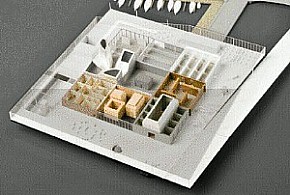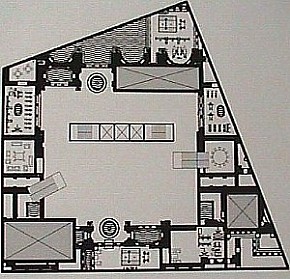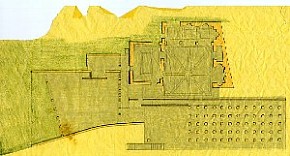2009.10.06 15:59
Examples of modern exterior with traditional interior
somewhat akin to the Getty...
 
REX, Munch Museum, 2009
The compartmentalized approach leads to any number of mix-up possibilities.
otherwise...

Level 1: lobby, bar. restaurant, spa, fitness, banquet rooms.
OMA and Herzog & de Meuron, Hotel Astor Place, 1999.

SL, Mayor's House, 1990.
| |
2009.11.16 09:55
The current state of Architectural Theory
"The ability of the computer to locate every point on a carved surface does away with the need for rational comprehension on the part of the designer in conceiving, or the observer in perceiving, a building. Thanks to the computer, pure empiricism has no longer any practical need for the mediating grasp of the intellect. The maximum of an empirical nominalism coexists with the maximum of abstraction. The space between nominalism and abstraction is left void. The mind no longer needs to understand itself. After a long evolutionary detour, human thought returns to its primitive instinctual roots."
Colquhoun (2005)
"...I was entranced by the work of James Gamble Rogers, the architect who designed most of Yale's Gothic and Georgian architecture in the 1920s and 1930s. Roger's determinedly nonideological stance, his avoidance of theory in favor of what can only be called intuitive design, was liberating. It was alright for architecture to be about feeling good, I suddenly realized; stage sets were not immoral. It was the perfect epiphany for a twenty-year-old who was just beginning to learn about empirical experience and only starting to trust his eye."
Goldberger (2009)
2009.11.16 11:37
The current state of Architectural Theory
Colquhoun isn't even saying "machine language" is "human being's unconscious."
....go ahead, argue it out. (fugi film platitudes not included?)
What if contemproary society actually is "narrcisstic Imaginary" and "Heroic (superstar's) Symbolics"?
I was just at the supermarket and apparently Angelina recently collapsed and is still losing weight. May I suggest stage right.
the Pitti penence:
I don't know why you say Dubai, and I say hell no. Hell no! Hell no!
2009.11.16 12:49
The current state of Architectural Theory
...what exactly is it that you see here as my opinion?
2009.11.16 14:03
The current state of Architectural Theory
I'm not offended. I'm merely asking you to clarify your statement as to my opinion.
You state my opinion is 'exactly structuralist's' and apparently because my opinion is 'exactly structuralist's' architecture theory has failed to understand post-structuralism or neo materialism.
Could you at least tell us what you mean by 'my opinion'.
2009.11.16 15:25
The current state of Architectural Theory
Jargon aside, it is now progressively easier for intuitive design intentions to become reality.
2009.11.17 11:42
The current state of Architectural Theory
Alan Colquhoun, Collected Essays in Architectural Criticism (2009), p. 342. Within the lecture "Changing Museum" (2005).
The passage relates specifically to Gehry's Guggenheim Bilbao, and was included here because it somewhat relates to my 'opinion' 2008.08.22 22:05.
| |
2009.11.17 16:17
The current state of Architectural Theory
I like my raspberry bushes because they bear fruit twice a year, mid-spring and mid-autumn (like right now). And although still seasonal in their development, there's also this kind of double-helix thing about it.
Architecture theory structured as DNA?
Colquhoun's passage isn't really about how modeling systems work, rather how digital (modeling) data can be manufactured. It's about the voiding of the mediating grasp within the design/execution process. (Not too dissmilar from the voiding of the mediating grasp within the design/execution of self-publising, eg, blogging.)
2009.11.17 16:27
The current state of Architectural Theory
"i thought he was saying that you can like a form because it's sexy without needing to know anything else about it - or even needing to know why. eye to pleasure centers directly - do not pass through intellect. will have to think a little more about the implications of this hypothesis, whether for good or bad."
Steven Ward
2009.11.17 16:48
The current state of Architectural Theory
...that's closer to what Goldberger said. It looks like you're interpolating from both quotations, which, for the most part, is fine, because there is, as you just unwittingly demonstrated, something about the the two quotations intertwined that could well be the germinating point of a[n architectural] value system.
2009.11.17 17:42
The current state of Architectural Theory
Perhaps the struggle today is more with the dual reality of "anything goes" and "whatever works".
2009.11.18 11:31
The current state of Architectural Theory
...it's not that "there really isnt meant to be any real thought there" but that "intellectual rigor" really isn't necessary to design architecture. In fact, it could well be asked: Does it really behoove us to mask our lack of depth and our inability to achieve real, effective, incisive strength in our work with intellectual nonsense? A lack of depth and an inability to achieve real, effective, incisive strength are not fixed with intellectual rigor, rather they are fixed via design rigor. The architectures of Zumthor, Predock and Chipperfield (for example) do not stand out because of their intellectual rigor, but because of their design rigor.
Yet design rigor isn't always necessary to create architecture either. Gehry's architecture exhibits a very high-grade design facileness, and maybe that is indeed something rare.
As for the "computer people", the various/sometimes architectures of Hadid and UnStudio (again for example) well demonstrate being beyond "figuring it out", and they're even doing it rigorously.
I'm not here trying to express my opinion, as much as I'm experimenting with establishing some kind of baseline for architectural theory to build upon. I am of the opinion, however, that honesty, or at least objective observations and assessments of present conditions, is a fair place to start
| |
2009.11.18 13:40
The current state of Architectural Theory
Is it Eisenman's words, or Eisenman's designs that might of made the likes of UNStudio, FOA and Lynn possible?
2009.11.19 17:32
The current state of Architectural Theory
Computers are not competing with thinking.
For the sake of the argument here, computers greatly augment/assist instinctive/intuitive design thinking. Designing instinctually/intuitively (for example, Villa Savoye derivatives) doesn't mean you're designing without thinking.
2009.11.20 11:33
The current state of Architectural Theory
...the examples are intuitive in that that's how I now (use the computer to) sketch. Intuitive sketching is a "good way to find new things." Granted, this type of sketching is rigorous, but I also (use the computer to) sketch loosely[link: QABackg index]--especially see Ludi002, Maison l'Homme, and Villa Savoye and Maison l'Homme.
Personally, I'm not looking to guide the process, but to learn from it and/or find inspiration in it. I also just wanted to show that being intuitive with the aid of the computer isn't just about curved stuff.
It could be I feel my work is genuinely emcompassing enough in that I've embraced non-place[link: 18/1702] a long time ago. ;-)*
Perhaps you should try and embrace non-place yourself, and even try it with a non-guide, except maybe your instincts.
*don't let my glibness fool you
2009.11.20 13:27
The current state of Architectural Theory
...did I answer your question about what I mean by intuitive or not?
2009.11.20 15:34
The current state of Architectural Theory
Here's what comes to my mind when I (too) wrestle* with then what.
I made a bunch of collages during the summer of 2001. These were done for art, and not for architecture, but there was some architectonics within some of the collages.
Last year there was "has the sun finally set on oma?" thread here at archinect/forum. To join in the discussion I wanted to post images of a couple recent OMA projects that I like. And while finding the images online and seeing the projects again and trying to figure how to explain why I like the projects I noticed a kind of strange resemblance to two of the collages I did in 2001. (I did not think that maybe OMA saw the collages online.) What happened at that moment of 'recognition' was an insight into how I myself could have found architectural inspiration in the collages.
2009.11.20 15:46
The current state of Architectural Theory
similarly...

Quaestio Abstrusa Background No. 191
28 April 2001
manipulated digital image file
660 x 640 pixels

OMA/Rem Koolhaas
Quartier des Halles
2003 2004
|